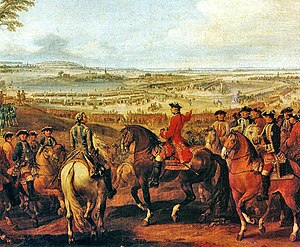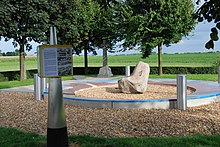Battle of Lauffeldt
| date | July 2, 1747 |
|---|---|
| place | between Maastricht ( Republic of the Seven United Provinces ) and Tongeren ( Liege Monastery ) |
| output | French victory |
| Parties to the conflict | |
|---|---|
| Commander | |
| Troop strength | |
| 60,000 men | 80,000 men |
| losses | |
|
approx. 4,000 dead, wounded and missing |
10,000 dead, wounded and missing |
European theater of war: Mollwitz * - Chotusitz * - Dettingen - Bergen op Zoom - Maastricht - Toulon - Pfaffenhofen - Fontenoy - Hohenfriedberg ** - Soor ** - Hennersdorf ** - Kesselsdorf ** - Piacenza - Roucourt - Kap Finisterre 1 - Lauffeldt - Kap Finisterre 2
(*) First Silesian War - (**) Second Silesian War
Indian Theater of War: First Carnatic War
American Theater of War: King George's War
The Battle of Lauffeldt (sometimes referred to as the Battle of Val or (due to the different spelling of the place name) Battle of Laffeldt ) of July 2, 1747 between the Austrians , Dutch , British and Hanoverians on the one hand and the French on the other, took place west of Maastricht during the War of the Austrian Succession took place and ended with a victory for the French. Lauffeldt ("Lafelt") is now part of the Vlijtingen sub-municipality of the municipality of Riemst in Belgium .
course
The Duke of Cumberland , the commander in chief of the pragmatic army of the allies, planned in June 1747 with 60,000 men an attack on a corps of the Count of Clermont detached from the French main army under Marshal Moritz von Sachsen . With a forced march, the marshal hurried to the aid of his threatened general and positioned himself on the area that Cumberland himself had wanted to take. The allies now faced 80,000 French.
After a vanguard battle between French and British cavalry under Sir John Ligonier , the Allied infantry arrived on the battlefield. Their position was determined by a chain of villages, for the benefit of which there was a heated argument between Ligonians and Cumberland. While the former demanded that the villages be fortified and held by the infantry, Cumberland ordered that the soldiers should form in open terrain behind the villages. That is why the regiments first marched into the towns and then out again. The villages of Lauffeldt and Vlytingen were at the center of the allies. The French attacked first on the left wing, captured two villages and then attacked Lauffeldt, Vlytingen and Val , where they were repulsed. Cumberland then requested reinforcements from the Austrians on the right wing, but they did not move. The French renewed their attacks and slowly pushed the British infantry out of the villages. The village of Val allegedly changed hands five times. In the battles there, the future General James Wolfe was particularly distinguished. A counterattack pushed the French back, but after receiving reinforcements from their side, they finally managed to push the British back. A defining moment was reportedly the escape of Dutch units, which also confused the British lines. Cumberland is said to have lost his nerve and hastily ordered the retreat. Moritz von Sachsen now concentrated his troops in a massive attack. At that moment Ligonier attacked the French with three British cavalry regiments. The attackers suffered heavy casualties and Ligonier was taken prisoner, but the delay enabled Cumberland's army to withdraw in an orderly manner, carrying most of the guns, 700 prisoners and several captured flags. The battle was very costly for both sides; the French are said to have lost no fewer than 10,000 men, including General Emmanuel-François-Joseph de Bavière , and the allies about 4,000. A British officer, in view of the heavy French losses, said that he wished the enemy such a victory every day. The leadership qualities of Cumberland are criticized, who did not recognize the importance of the villages as the backbone of his position and allegedly let himself be affected in his judgment by his jealousy of Ligonier, whom he is said to have envied for his courage and cold-bloodedness on the battlefield. In the end he put the whole army in danger with his hasty withdrawal order.
consequences
The battle of Lauffeldt allowed the French to conquer more cities. This battle was the last major battle of the War of the Austrian Succession, as it was ended the following year by the Second Peace of Aachen . The French returned their conquests in Flanders in exchange for Louisbourg ( Canada ), and Marshal Moritz von Sachsen withdrew into private life.

